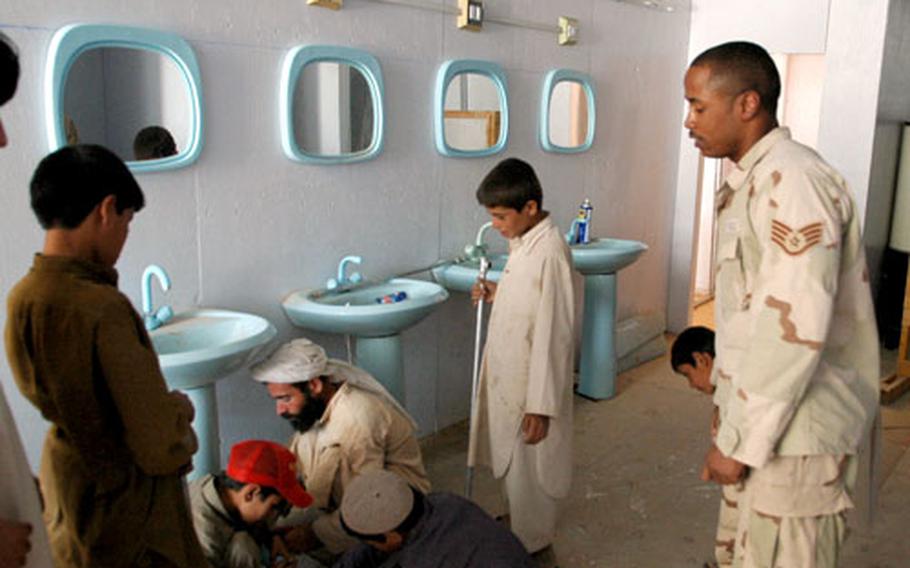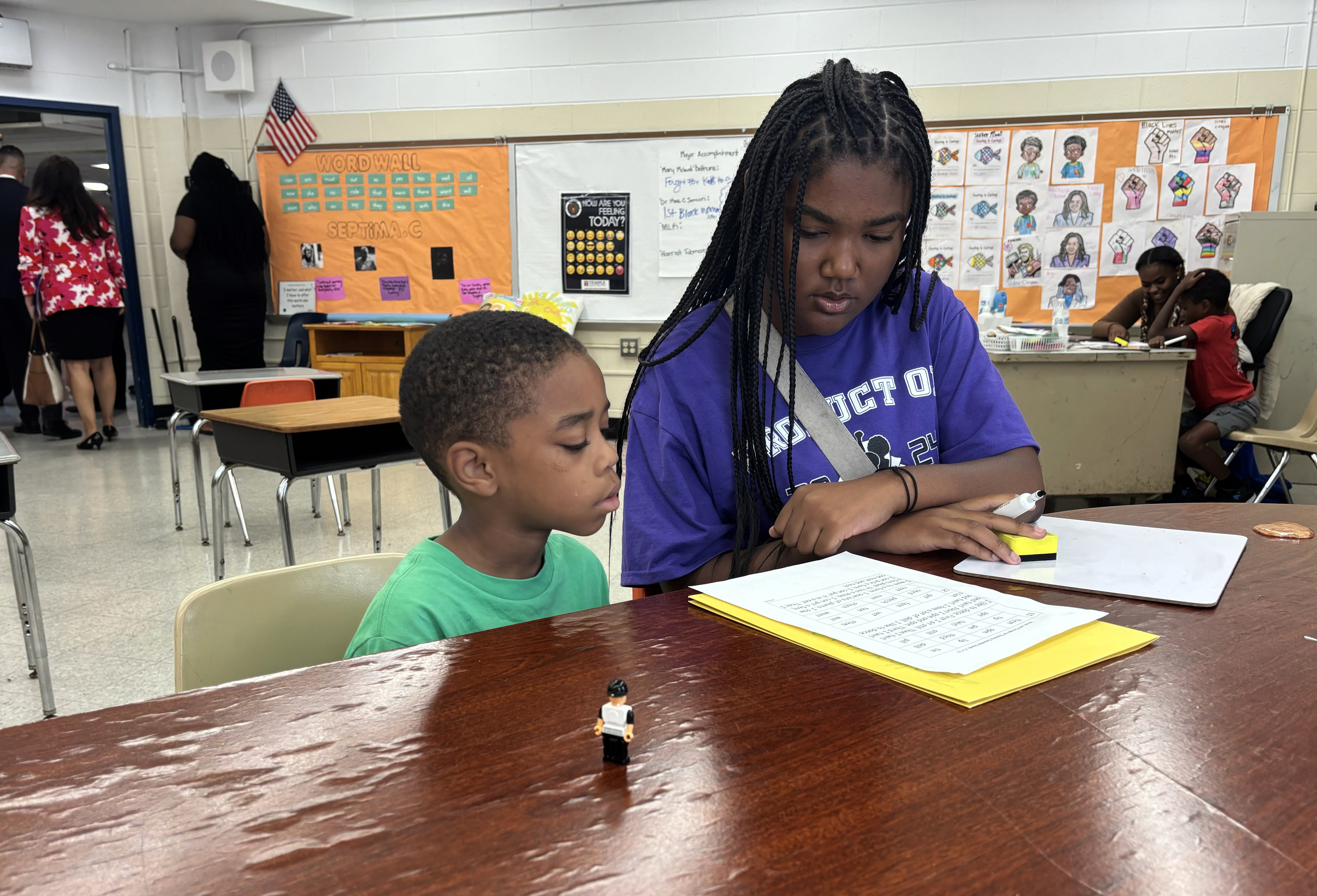
Trade School Classes in Afghanistan

Staff Sgt. William Johnson directs students practicing their plumbing skills during classes Tuesday run by the Qalat provincial reconstruction team. (Leo Shane III / S&S)
Introduction
The Qalat provincial reconstruction team in southeastern Afghanistan has been offering trade school classes to local Afghans. These classes aim to provide the foundation for a professional career and contribute to the achievement of the Sustainable Development Goals (SDGs).
Challenges Faced
- Low level of education among the Afghan population
- Lack of basic knowledge in subjects like biology and chemistry
- Taliban opposition to education leading to limited resources
Success Stories
Despite the challenges, the trade school classes have seen some success in certain areas:
- Computer classes: Local instructors with knowledge of word processing and networking have taken over teaching responsibilities, resulting in entry-level technicians.
- Electronics and plumbing classes: Students have successfully installed overhead lighting, sinks, and lighted mirrors, and have gained carpentry skills.
- Auto repair shop and welding classes: These classes have also reported success and enthusiasm among students.
Education Difference
The education difference between the average Afghan and the typical U.S. servicemember creates some confusion and frustration in nursing and EMT classes. However, it is expected that future students will be easier to teach as they are still in school and have better reading abilities.
Conclusion
The trade school classes offered by the Qalat provincial reconstruction team have made significant progress in providing professional skills to the Afghan population. These efforts contribute to the achievement of SDGs, particularly Goal 4 (Quality Education) and Goal 8 (Decent Work and Economic Growth).
SDGs, Targets, and Indicators
1. No Poverty
- Target 1.4: Ensure that all men and women, in particular the poor and the vulnerable, have equal rights to economic resources, as well as access to basic services, ownership, and control over land and other forms of property.
- Indicator 1.4.2: Proportion of total adult population with secure tenure rights to land, with legally recognized documentation and who perceive their rights to land as secure, by sex and type of tenure.
4. Quality Education
- Target 4.3: By 2030, ensure equal access for all women and men to affordable and quality technical, vocational, and tertiary education, including university.
- Indicator 4.3.1: Participation rate of youth and adults in formal and non-formal education and training in the previous 12 months, by sex.
8. Decent Work and Economic Growth
- Target 8.5: By 2030, achieve full and productive employment and decent work for all women and men, including for young people and persons with disabilities, and equal pay for work of equal value.
- Indicator 8.5.2: Unemployment rate, by sex, age group, and persons with disabilities.
9. Industry, Innovation, and Infrastructure
- Target 9.2: Promote inclusive and sustainable industrialization and, by 2030, significantly raise industry’s share of employment and gross domestic product, in line with national circumstances, and double its share in least developed countries.
- Indicator 9.2.1: Manufacturing value added as a proportion of GDP and per capita.
11. Sustainable Cities and Communities
- Target 11.3: By 2030, enhance inclusive and sustainable urbanization and capacity for participatory, integrated, and sustainable human settlement planning and management in all countries.
- Indicator 11.3.1: Ratio of land consumption rate to population growth rate.
16. Peace, Justice, and Strong Institutions
- Target 16.7: Ensure responsive, inclusive, participatory, and representative decision-making at all levels.
- Indicator 16.7.1: Proportions of positions (by sex, age, persons with disabilities, and population groups) in public institutions (national and local legislatures, public service, and judiciary) compared to national distributions.
Analysis
1. The issues highlighted in the article are connected to the following SDGs:
– No Poverty (SDG 1)
– Quality Education (SDG 4)
– Decent Work and Economic Growth (SDG 8)
– Industry, Innovation, and Infrastructure (SDG 9)
– Sustainable Cities and Communities (SDG 11)
– Peace, Justice, and Strong Institutions (SDG 16)
2. Specific targets under these SDGs that can be identified based on the article’s content are:
– Target 1.4: Ensure that all men and women, in particular the poor and the vulnerable, have equal rights to economic resources, as well as access to basic services, ownership, and control over land and other forms of property.
– Target 4.3: By 2030, ensure equal access for all women and men to affordable and quality technical, vocational, and tertiary education, including university.
– Target 8.5: By 2030, achieve full and productive employment and decent work for all women and men, including for young people and persons with disabilities, and equal pay for work of equal value.
– Target 9.2: Promote inclusive and sustainable industrialization and, by 2030, significantly raise industry’s share of employment and gross domestic product, in line with national circumstances, and double its share in least developed countries.
– Target 11.3: By 2030, enhance inclusive and sustainable urbanization and capacity for participatory, integrated, and sustainable human settlement planning and management in all countries.
– Target 16.7: Ensure responsive, inclusive, participatory, and representative decision-making at all levels.
3. The article does not explicitly mention any indicators that can be used to measure progress towards the identified targets. However, some indicators can be inferred based on the information provided:
– Indicator 1.4.2: Proportion of total adult population with secure tenure rights to land, with legally recognized documentation and who perceive their rights to land as secure, by sex and type of tenure.
– Indicator 4.3.1: Participation rate of youth and adults in formal and non-formal education and training in the previous 12 months, by sex.
– Indicator 8.5.2: Unemployment rate, by sex, age group, and persons with disabilities.
– Indicator 9.2.1: Manufacturing value added as a proportion of GDP and per capita.
– Indicator 11.3.1: Ratio of land consumption rate to population growth rate.
– Indicator 16.7.1: Proportions of positions (by sex, age, persons with disabilities, and population groups) in public institutions (national and local legislatures, public service, and judiciary) compared to national distributions.
4. Table of SDGs, Targets, and Indicators:
| SDGs | Targets | Indicators |
|——|———|————|
| 1. No Poverty | Target 1.4: Ensure that all men and women, in particular the poor and the vulnerable, have equal rights to economic resources, as well as access to basic services, ownership, and control over land and other forms of property. | Indicator 1.4.2: Proportion of total adult population with secure tenure rights to land, with legally recognized documentation and who perceive their rights to land as secure, by sex and type of tenure. |
| 4. Quality Education | Target 4.3: By 2030, ensure equal access for all women and men to affordable and quality technical, vocational, and tertiary education, including university. | Indicator 4.3.1: Participation rate of youth and adults in formal and non-formal education and training in the previous 12 months, by sex. |
| 8. Decent Work and Economic Growth | Target 8.5: By 2030, achieve full and productive employment and decent work for all women and men, including for young people and persons with disabilities, and equal pay for work of equal value. | Indicator 8.5.2: Unemployment rate, by sex, age group, and persons with disabilities. |
| 9. Industry, Innovation, and Infrastructure | Target
Behold! This splendid article springs forth from the wellspring of knowledge, shaped by a wondrous proprietary AI technology that delved into a vast ocean of data, illuminating the path towards the Sustainable Development Goals. Remember that all rights are reserved by SDG Investors LLC, empowering us to champion progress together.
Source: stripes.com

Join us, as fellow seekers of change, on a transformative journey at https://sdgtalks.ai/welcome, where you can become a member and actively contribute to shaping a brighter future.






